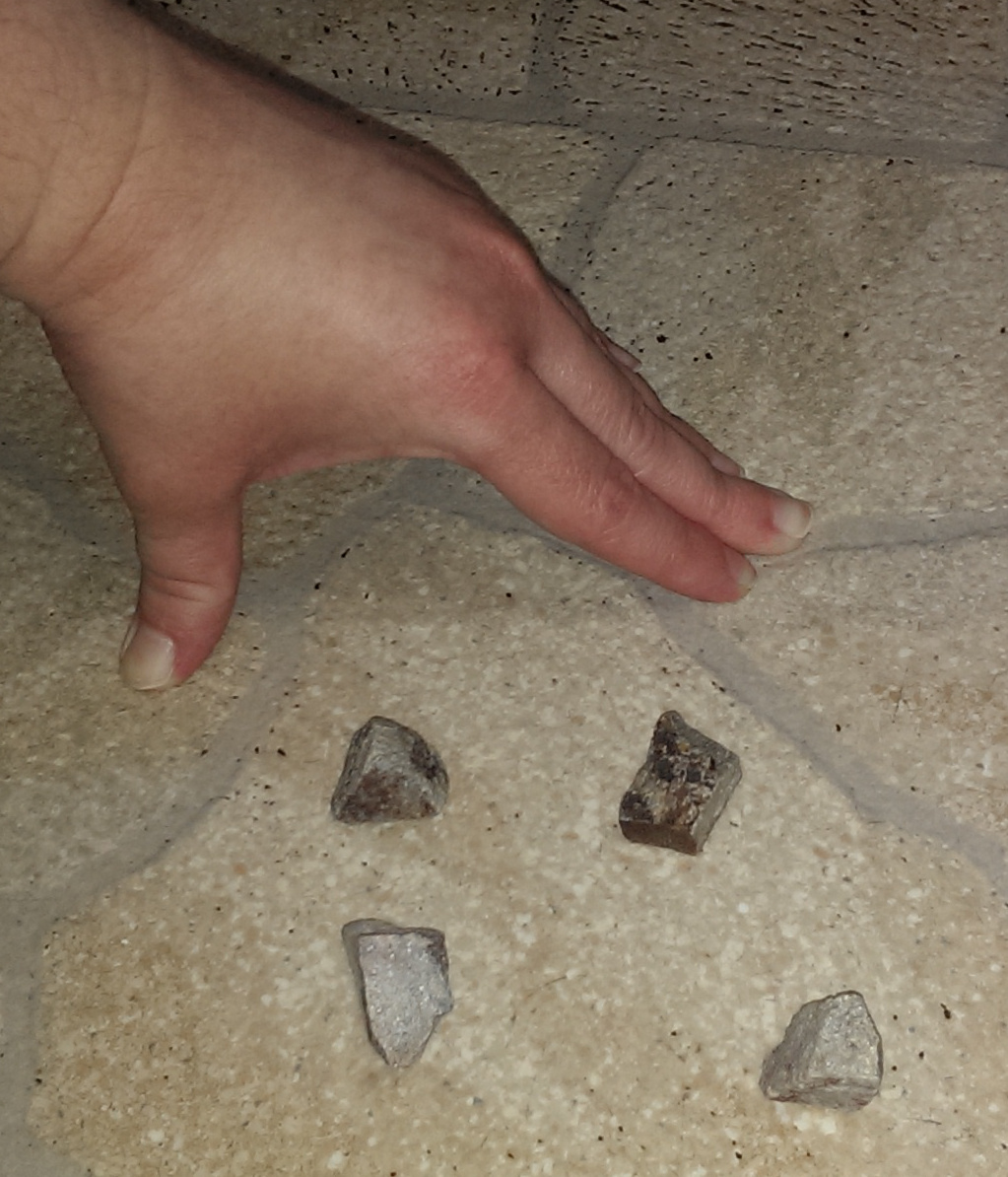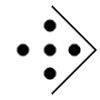
As the title of the game suggests, it was once played with actual bones. The playing pieces were knucklebones from mutton (sheep) legs. The Ancient Greeks called them "astragaloi." They could be used both in gambling games like dice and for telling the future (Grunfeld 162).
The game described here, which is actually called Knucklebones, is the ancestor of modern Jacks, also called Fivestones. According to Sophocles, Knucklebones was invented by Palamedes, who taught it to Greek soldiers fighting in the Trojan War, although it probably came from Asia originally. The Romans also played Knucklebones, and Roman soldiers brought the game to other countries. However, they were not solely responsible for the spread of the game because different versions of it are played all over the world, including places the Romans never visited (Grunfeld 162).
Knucklebones
The rules for this game come from Games of the World edited by Frederic Grunfeld, pp. 162-163, with some additional information from The Way to Play by the Diagram Group, pp. 130-132.
Players: 2 to 4 (it's possible with more, but it can get awkward with too many people), it can also be played as a solo game
Object: To complete different phases (or "figures") of the game which involve tossing, catching, and picking up the "knucklebones" in different ways.
Equipment: Relax, you don't need real knucklebones to play this game. It can be played with various small objects, like stones, mini dice from a game store, or modern jacks. Whichever you choose, you will need a set of five.
The Jack: Because there is no ball in Knucklebones, like there is in a modern jacks set, one of the knucklebones will be used in place of the ball. This knucklebone is actually called the "jack." Of course, knucklebones (or the small objects you'll be using in place of the bones) don't really bounce, so when you toss the jack, you'll have to catch it before it hits the ground.
Basic Rules: The players play their way through different phases or "figures" of the game, completing each with no mistakes before moving on to the next one. As in modern Jacks, if a player accidentally bumps one of the other knucklebones besides the one he's picking up, drops a knucklebone, or fails to catch the jack in time, his turn ends. On his next turn, he will have to repeat the figure he was on from the beginning. He won't be able to move on to another figure until he finishes the one he's currently playing correctly.
Figures: The phases of the game can vary, depending on how the players want to play. The players are allowed to choose which figures they want to use and the order of the figures, although they have to be played in a sequence, one after another. Some of the figures are known by multiple names because the game was played in many different places, but the basic concepts are the same.
One basic figure that you can use to start was shown in a fresco found in Pompeii. The player throws the five knucklebones straight up with one hand, catching them all on the back of his hand (if he can). Then, he tosses them again from the back of his hand so he can catch them in his palm. You can use this figure to determine the order of play. The player who can catch the most knucklebones in this figure gets to be the first player.
Some of the figures in Knucklebones are almost identical to modern Jacks. Here is a basic description of some common Knucklebones figures:

- Ones
- The player tosses the knucklebones on the ground and then selects one of them to be the jack. With one hand, the player throws the jack straight up, picks up one of the other knucklebones, and catches the jack before it hits the ground. He keeps the knucklebone he just picked up in his other hand and picks up another in the same way. He keeps doing this until he's picked up all the knucklebones still on the ground.
- Twos
- This is like Ones, only the player picks up the knucklebones two at a time.
- Threes
- This is like Ones, only the player picks up three knucklebones at once and then picks up the remaining one by itself.
- Fours
- This is like Ones, only the player picks up the four knucklebones at the same time.
- Under the Arch
- The player scatters the knucklebones on the ground and uses his hand to make an arch near them with his thumb and forefinger touching the ground. With his other hand, he tosses the jack in the air and flicks a knucklebone under the arch before catching the jack. He continues flicking the knucklebones under the arch one at a time. As with the previous figures, he can repeat this figure by sending different numbers of knucklebones under the arch at a time in sequences from two to four. He must succeed with each number before he advances to the next.
- Stables
- This is a more complex version of Under the Arch. This time, the player holds his hand with the fingers spread apart and the fingertips touching the ground, forming four arches or "stables." The player tosses the jack and flicks a single knucklebone into a stable. If he can't actually get a knucklebone into a stable on one flick, he has to at least move it closer and catch the jack at the right time (Diagram Group 131). He does the same with each knucklebone, sending each one into a different stable. After he does that, he has to take each one out of the stables again.
- Toad in the Hole
- This is another variation of Under the Arch. In this version, the player has his thumb and forefinger touching to form a hole. He holds his hand so that the hole touches the ground and flicks the knucklebones through it one at a time at each toss of the jack. After he flicks the last knucklebone through the hole, he takes away the hand forming the hole and picks up all four knucklebones on a single toss of the jack, as in Fours.
- Jump the Ditch
- The player chooses one knucklebone to be the jack and sets the others on the ground in a line with a few inches between each one. The player tosses the jack and picks up just the first and third knucklebones in the line. Then, he tosses the jack again and picks up the second and fourth knucklebones.

Winning: The winner is the first player to successfully complete all the figures the players have agreed on in sequence.

